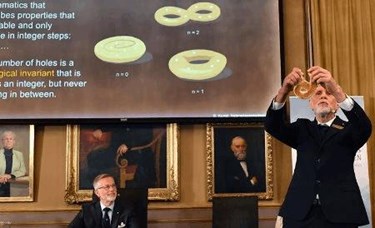Theoretical Research Into Phases Of Matter Claims Nobel Prize In Physics – What's Next?
By Ed Biller

For their work in advancing materials science by using mathematics to explain strange phenomena in unusual states of matter, David Thouless, Duncan Haldane, and Michael Kosterlitz were awarded the Nobel Prize in Physics 2016 earlier this month.
Specifically, the prize was presented to the three men “for theoretical discoveries of topological phase transitions and topological phases of matter.” The scientists also will share the 8-million kronor ($925,176) prize granted by the Royal Swedish Academy of Sciences in Stockholm.
While the three Nobel Laureates all are British, each is associated with an American university. Thouless, 82, is a professor emeritus at the University of Washington; Haldane, 65, is a professor at Princeton University; and Kosterlitz, 73, is a professor at Brown University, as well as a visiting lecturer at Aalto University in Helsinki. You can see the math behind their discovery here.
In short, the researchers used topology — a branch of mathematics that describes properties that change step-wise, only in integers — to explain what was happening when matter changed phases in unusual situations. The researchers looked beyond common phase transitions, like a liquid freezing to a solid or condensing into gas, and examined the weird changes that occur with very thin layers of matter, very cold substances, or extreme magnetic fields. For example, in extreme cold, the resistance otherwise encountered by moving particles can cease, or certain materials can become magnetic.
“The work helps explain why some materials have unexpected electrical properties, such as superconductivity, and in [the] future the work could pave the way for quantum computers,” stated The Guardian. The article also explained that “Thouless has been given a larger share because he made crucial contributions to both the advances (phase transitions and phases of matter) cited in the prize.”
Another triumph of the research, according to Dr. Michal Lipson, Eugene Higgins Professor of Electrical Engineering at Columbia University, is the demonstrated “ability to break the reciprocity of light” — a principle so ingrained in photonics that it is used to confirm the correct performance of experiments.
The immediate questions that come to mind each year, after the prize is awarded, are:
- What are the practical applications of this discovery?
- What discovery or breakthrough will be honored next?
To answer the first question, Thors Hans Hansson, a professor of theoretical physics who was on the Nobel Committee for Physics this year, told NPR that the discoveries could have applications in electronics and computing, but pointed out that the practicality question misses the point. Rather, the prize recognizes the trio’s "profound insights into physics" on a theoretical level.
That said, the development of topological insulators — which act as insulators on the inside, but work as normal conductors on the outside — has been a direct result of the trio’s body of work since the 1970s. Like other ahead-of-their-time innovations (think Ada Lovelace’s 1843 creation of the first algorithm intended to be computed by a machine), topological insulators simply are waiting for technologies and applications that can take advantage of their properties. One such insulator, stanine, which conducts electricity at high temperatures with little resistance, has been pegged as a down-the-road replacement for copper in computer components.
As for “what’s next,” the answer could come from anywhere. The Nobel Committee for Physics bounces between discoveries that have an immediate payoff — such as Isamu Akasaki, Hiroshi Amano, and Shuji Nakamura’s 2014 recognition "for the invention of efficient blue light-emitting diodes which has enabled bright and energy-saving white light sources" — and more general physics, like last year’s recognition of Takaaki Kajita and Arthur McDonald, who discovered that neutrinos have mass and can change from one form to another as they pass through space.
A popular choice for the 2017 award is the work of researchers at the Laser Interferometer Gravitational-Wave Observatory (LIGO), which confirmed the existence of gravitational waves. (The discovery missed the deadline for the 2016 award.) However, given that some discoveries’ significance takes years to be acknowledged, confirmed, and formally recognized, the answer may be months from popping up as a topic around the physics community water cooler.
What scientific breakthrough, in your opinion, demands the committee’s attention for 2017? I look forward to your thoughts in the Comments section below.
